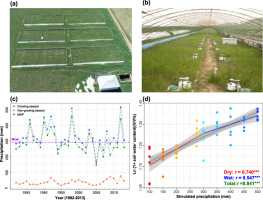Soil Biology and Biochemistry ( IF 9.8 ) Pub Date : 2020-01-11 , DOI: 10.1016/j.soilbio.2020.107717 Ying Wu , Jianping Wu , Muhammad Saleem , Bing Wang , Shuijin Hu , Yongfei Bai , Qingmin Pan , Dima Chen

|
Ecological classification has been proposed as a way to more tightly link microbial communities and ecosystem functions, but few studies have attempted to relate ecological classifications of microbial communities with specific ecosystem functions. Here, we conducted a 3-year experiment with nine levels of artificial precipitation (100–500 mm) in a typical semi-arid steppe. The first five levels (≤300 mm) were considered a “dry” gradient, and the last five (≥300 mm) were considered a “wet” gradient. Increases in precipitation under dry and wet gradients did not alter the alpha diversities of soil bacterial, soil fungal, or plant communities, except that increases in precipitation under the dry gradient decreased bacterial alpha diversity. Increases in precipitation under the dry and wet gradients altered the composition of the soil bacterial community but did not alter the composition of the fungal or plant communities. Ecological clusters (ECs) based on the relationships between the relative abundance of phylotypes and dry and wet gradients were correlated with soil C or N mineralization rates; these ECs explained 14–28% of the total variance in soil C and N mineralization rates. In contrast, soil C or N mineralization rates were not correlated with the commonly measured properties (e.g., biomass and diversity) of plant, soil bacterial, and soil fungal communities. Our findings indicate that the grouping of soil microorganisms into ECs based on responses to precipitation gradients can provide insights into the relationships between soil organisms and ecosystem functions.
中文翻译:

基于土壤微生物系统型对降水响应的生态集群解释了生态系统功能
已经提出了生态分类作为更紧密地联系微生物群落和生态系统功能的方法,但是很少有研究试图将微生物群落的生态分类与特定的生态系统功能联系起来。在这里,我们进行了为期3年的实验,在一个典型的半干旱草原上进行了9种水平的人工降水(100-500毫米)。前五个级别(≤300 mm)被认为是“干”梯度,后五个级别(≥300 mm)被认为是“湿”梯度。在干梯度和湿梯度下的降水增加不会改变土壤细菌,土壤真菌或植物群落的α多样性,只是在干梯度下的降水增加会降低细菌的α多样性。在干,湿梯度下的降水增加,改变了土壤细菌群落的组成,但没有改变真菌或植物群落的组成。基于系统型相对丰度与干,湿梯度之间关系的生态集群(EC)与土壤碳或氮矿化率相关。这些EC解释了土壤C和N矿化率总变化的14–28%。相反,土壤碳或氮的矿化速率与植物,土壤细菌和土壤真菌群落的通常测量的特性(例如,生物量和多样性)不相关。我们的发现表明,基于对降水梯度的响应,将土壤微生物分为EC可以为深入了解土壤生物与生态系统功能之间的关系提供依据。









































 京公网安备 11010802027423号
京公网安备 11010802027423号